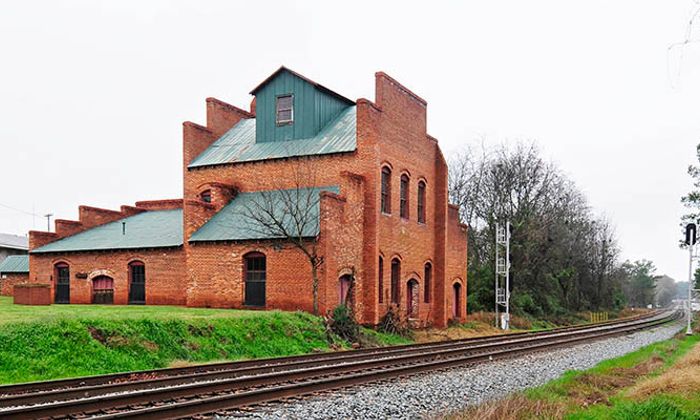Dorn Mill Center For History & Art – McCormick, SC
Listed on the National Register of Historic Places, the gristmill at this site was built in 1898 as a cottonseed oil mill and converted to a flour and grist mill in the 1920′s. This is one of the few remaining gristmills in the state.
Grist Mill is a term used to describe a mill that grinds any type of grain. The power for these mills was provided by the creek or river that they were built on that allowed the water to turn the wheel that turned the grinding stone to grind the grain to flour. There were a few mills powered by wind of by livestock but a watermill is the most common. In a watermill, a sluice gate is opened to allow water to flow onto, or under, a water wheel to make it turn. In most watermills, the water wheel was mounted vertically, i.e., edge-on, in the water, but in some cases horizontally (the tub wheel and so-called Norse wheel).

n most wheel-driven mills, a large gear-wheel called the pit wheel is mounted on the same axle as the water wheel and this drives a smaller gear-wheel, the wallower, on a main driveshaft running vertically from the bottom to the top of the building. This system of gearing ensures that the main shaft turns faster than the water wheel, which typically rotates at around 10 rpm.
The millstones themselves turn at around 120 rpm. They are laid one on top of the other. The bottom stone, called the bed, is fixed to the floor, while the top stone, the runner, is mounted on a separate spindle, driven by the main shaft. A wheel called the stone nut connects the runner’s spindle to the main shaft, and this can be moved out of the way to disconnect the stone and stop it from turning, leaving the main shaft turning to drive other machinery. This might include driving a mechanical sieve to refine the flour, or turning a wooden drum to wind up a chain used to hoist sacks of grain to the top of the mill house. The distance between the stones can be varied to produce the grade of flour required; moving the stones closer together produces finer flour.
The grain is lifted in sacks onto the sack floor at the top of the mill on the hoist. The sacks are then emptied into bins, where the grain falls down through a hopper to the millstones on the stone floor below. The flow of grain is regulated by shaking it in a gently sloping trough (the slipper) from which it falls into a hole in the center of the runner stone. The milled grain (flour) is collected as it emerges through the grooves in the runner stone from the outer rim of the stones and is fed down a chute to be collected in sacks on the ground or meal floor. A similar process is used for grains such as wheat to make flour, and for maize to make cornmeal.
In order to prevent the vibrations of the mill machinery from shaking the building apart, a gristmill will often have at least two separate foundations.
The Dorn Mill Center for History & Art contains original steam engines and equipment which were powered by sawdust and wood chips from the Dorn Lumber Yard.
Dorn Mill Center For History & Art
200 N Main St
McCormick, SC 29835
